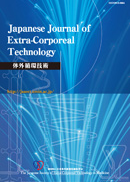All issues

Volume 42 (2015)
- Issue 4 Pages 381-
- Issue 1 Pages 1-
Volume 42, Issue 4
Displaying 1-3 of 3 articles from this issue
- |<
- <
- 1
- >
- >|
Original Articles
-
--- Focus to the report of JaSECT safety survey 2013 ---Koji Takai, Makoto Anno, Makoto Sonoda, Kiyoshi Yoshida2015Volume 42Issue 4 Pages 381-392
Published: 2015
Released on J-STAGE: January 07, 2016
JOURNAL FREE ACCESSWe carried out a questionnaire about the incidents, accidents and safety of cardiopulmonary bypass and PCPS(include ECMO) in 2013, and we describe considerations about the current state of the safety control of cardiopulmonary bypass based on its questionnaire results.This questionnaire targeted the Cardiopulmonary bypass use cases in both of 2011 and 2012 and its response rate was 76.6%. (423 of 552 establishments replied.(The 70,015 cases (35,015 of them in 2011 and 37,000 in 2012) used Cardiopulmonary bypass during the period subject to the questionnaire. On the 1,323 cases of them, some events were occurred despite the levels of affects to the patients and its incidence was 1.8%.It is necessary to draw up checklists and double-check them for the risk management, and also it is important the proper method for using safety equipment.We need to turn to not only the accidents but also the incidents or potentially dangerous incidents and develop the strategies for them.We hope the questionnaire results will be taken advantage as the one of the consultations in order to prevent any incident and need to continue to take similar and further surveys in the future.View full abstractDownload PDF (1000K) -
Shinya Komatsu, Shinji Ninomiya2015Volume 42Issue 4 Pages 393-399
Published: 2015
Released on J-STAGE: January 07, 2016
JOURNAL FREE ACCESSAlthough evaluation of extracorporeal circulation operation training is entrusted to leaders, environment is desirable to evaluate themselves by trainee when the target is a many people. At first establish a method capable of quantitatively evaluating the scenario training in order to build the environment, further it is necessary to clarify the relationship between the quantitative evaluation of the basic operation technique and scenario training in order to evaluate the overall competence.Targets in this study as 91 students of the training school, it was constructed environment to perform a quantitative evaluation of achievement by introducing a check sheet method to scenario training. Next, in order to examine the relationship between evaluation of the basic operation technique and scenario achievement, we compared the each of evaluation by classifying the groups to evaluate scenario training after the evaluation of the basic operation technique that is an object of the blood pressure maintenance and to evaluate in the reverse order.As a result, significant difference was not observed to the scenario achievement evaluation in the group was carried out before the evaluation of the basic operation technique, although blood pressure maintain skill level has increased significantly when scenario training. From this thing, it has been suggested need to consider the training style that integrates quantitative evaluation of basic operation technique and scenarios achievement in order to evaluate the overall competence of extracorporeal circulation operation.View full abstractDownload PDF (706K)
Research Article
-
Hiroyuki Oshima, Keiichi Tojo, Satoshi Kohira, Akikazu Takeda, Shigeta ...2015Volume 42Issue 4 Pages 400-406
Published: 2015
Released on J-STAGE: January 07, 2016
JOURNAL FREE ACCESS
- |<
- <
- 1
- >
- >|